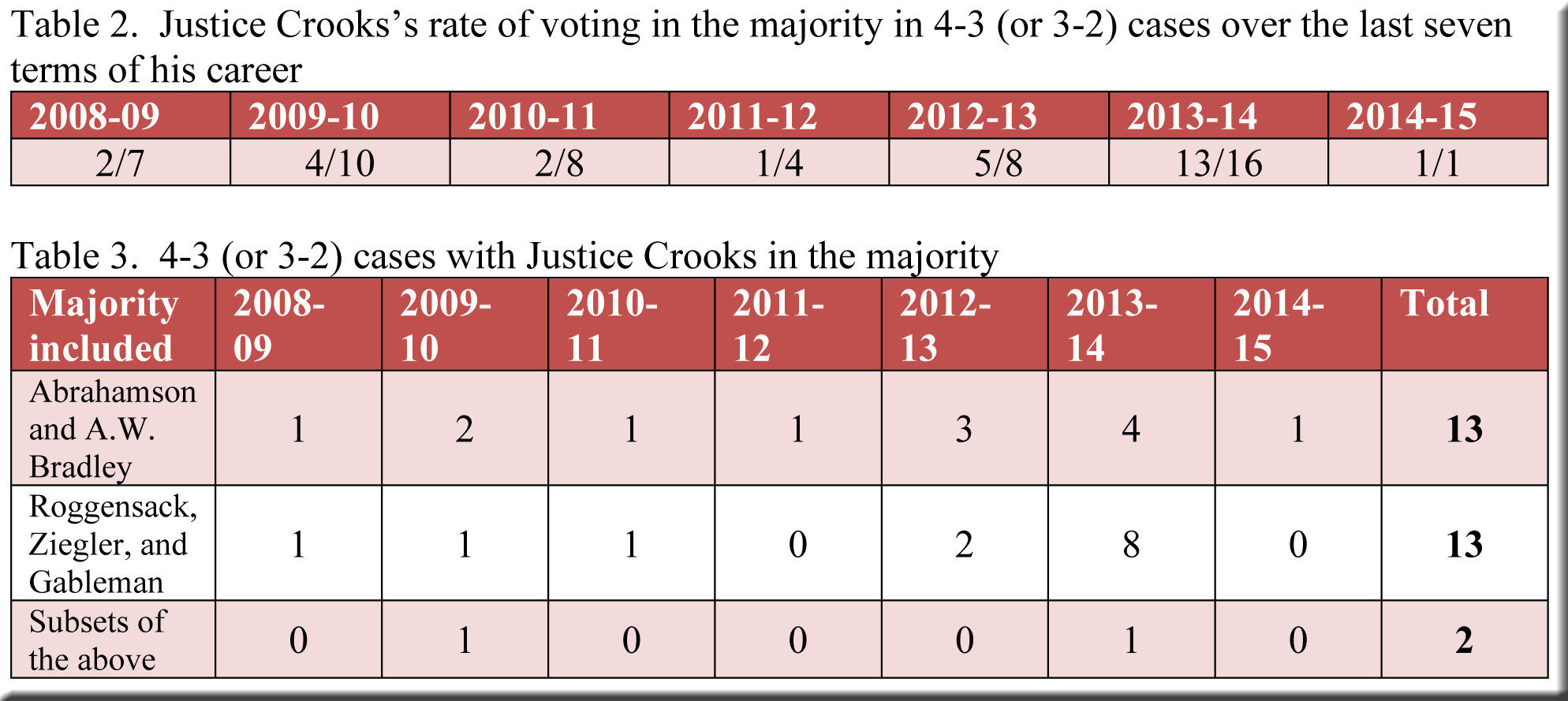So remarked an eminent appellate attorney recently, and such has indeed been the case to date in the most contentious supreme court decisions of the 2020-21 term. This is glaringly obvious in Table 1, which shows how regularly each justice has voted with the majority in the seven 4-3 decisions filed as of April 13, 2021. Justice Hagedorn’s vote has been essential in every one of these decisions—and in this regard no other justice is close.
What a difference a year makes—or, more accurately, the replacement of Justice Kelly by Justice Karofsky. In 2019-20, for instance, the court’s liberal standard-bearer, Justice A.W. Bradley, voted with the majority in only 30% (3/10) of the term’s 4-3 (and 3-2) decisions, whereas the figures for the court’s two most prominent conservatives, Justices Roggensack and Ziegler, were 82% (9/11) and 91% (10/11) respectively. Justice Hagedorn, meanwhile, joined the majority in only 40% (4/10) of these cases.[1] Thus, Table 1 is notable not only for Justice Hagedorn’s soaring percentage in 2020-21, but also for everyone else’s shares. The court’s most conservative justices (Roggensack, Ziegler, and R.G. Bradley) have appeared in the majority no more frequently than the three liberal justices (A.W. Bradley, Dallet, and Karofsky)—a striking change from the previous term.
Another way to sense the significance of Justice Karofsky’s defeat of Justice Kelly is as follows. Of the eleven 4-3 (or 3-2) decisions filed in 2019-20, the majorities in eight of them consisted of justices generally labelled conservative—that is, four votes from among Justices Roggensack, Ziegler, R.G. Bradley, Kelly, and Hagedorn. In only three of the eight cases, however, did Justice Hagedorn cast one of the conservative majority’s votes, meaning that in five of the eight cases, the conservatives could still win without him.
In 2020-21, with Justice Kelly now supplanted by Justice Karofsky, the remaining three conservatives can no longer win without Justice Hagedorn, and, with him, they have prevailed in three of the seven 4-3 decisions so far this term—a “victory total” no greater than that of the three liberal justices joined by Justice Hagedorn, as noted in Table 1.[2]
The change can be seen more clearly by zeroing in on the different voting patterns of Justices Kelly and Karofsky in 4-3 decisions. Back in 2019-20, Justice Kelly was such a dependable ally for Justices Roggensack and Ziegler—siding with them in eight of the eleven 4-3 majorities—that they rarely needed Justice Hagedorn. In contrast, Justice Karofsky has not joined the Roggensack/Ziegler pair in any of the seven 4-3 decisions to date in 2020-21, and thus Justice Hagedorn has become indispensable to the court’s conservative core (as well as its liberal faction) in these contentious cases. At least in 2020-21 the lesson does appear to be that, in order to succeed in a tight decision, “you’ve gotta win Hagedorn.”
Perhaps Justice Hagedorn’s voting record in 4-3 cases may come to resemble in some respects that of the late Justice Patrick Crooks, who did not conspicuously favor either the liberals or the conservatives in cases with one-vote margins. Justice Crooks was not crucial in 4-3 majorities, as detailed in Table 2, but he did distribute his votes evenly between majorities that featured liberals (Justices Abrahamson and A.W. Bradley) and those in which conservatives dominated (Justices Roggensack, Ziegler, and Gableman), as displayed in Table 3.[3]
It will be interesting to see if Justice Hagedorn continues to play a similar role during the remainder of 2020-21 and beyond.
[1] The sole 3-2 decision came in State v. Mose B. Coffee, in which Justices Roggensack, Ziegler, and Kelly formed the majority, and Justices A.W. Bradley and Hagedorn did not participate.
[2] The “mixed majority” in the remaining 4-3 decision (Ted Ritter v. Tony Farrow) consisted of Justices R.G. Bradley, Dallet, Hagedorn, and Karofsky.
[3] Regarding Table 3, in 2009-10, Justice Crooks’s “subsets” vote came in a majority that included, along with him, Justices Abrahamson, Prosser, and Ziegler (in Pries v. McMillon). In 2013-14, his “subsets” vote came in a majority that included, along with him, Justices Abrahamson, Prosser, and Gableman (in Legue v. City of Racine).


I accidentally “unsubscribed.” Alan—would you please resubscibe me. Thank you.
Janine Geske
Janine.geske@marquette.edu